What is a Plate Press?
Plate presses are among the simplest and most effective chest exercises that also develop your shoulder, tricep, and core. The objective is to grab a weight plate and raise it in front of your chest like you would during a front plate raise. But, instead of lowering it, you have to bring the plate to your chest and press it horizontally. Doing so might seem simple enough, but the movement trains your entire body and pushes several major muscle groups to their limits.
The plate press might seem weird at first glance, but it covers many criteria that make an exercise effective. For one, the movement offers a good range of motion. You bring the plate to your chest, then press it far in front of you by extending your arms.
Second, the plate press requires significant core involvement for you to remain stable, which is excellent for overall athleticism and injury prevention. Staying balanced is simple enough when the plate is against your chest muscles, but it becomes increasingly difficult as you extend your arms and press the weight away from your center of gravity.
Third, the plate press trains multiple muscle groups and offers a decent overloading potential. You’re not just training your chest but also your triceps, shoulders, serratus anterior, back, and midsection. All of that is possible with minimal equipment, making the movement a great option for home training.
Aside from building muscle effectively and making you more athletic, the plate press makes you more functional. Everyday tasks that involve upper body musculature and rely on good stability become more accessible, making you more independent. We recommend including the plate press near the middle of your push workouts, possibly even as the last chest exercise. Start with a lighter plate to get used to the proper execution and do over 15 slow and controlled repetitions.
Level of Exercise: Intermediate
How to do a Plate Press

- Grab a weight plate evenly, extend your arms, and have the bottom supported against your upper thighs. Start with a 10 or 15-lb plate to get a good feel for the movement.
- Bring your shoulders back and down, engage your abs, squeeze your glutes, and raise the weight plate horizontally and in front of your chest. Keep your elbows extended and have your wrists in a neutral position (facing one another).
- Have your feet hip-width apart with toes pointing slightly out and heels in contact with the floor. Maintain a slight bend in your knees.
- Take a breath and bring the weight plate to your chest muscles without flaring your elbow. Draw the plate in until it taps your torso.
- Press the plate forward and slightly up, squeezing your chest as hard as possible near the top. The plate should end at chest level or slightly higher. Use a moderate tempo and focus on engaging your chest from the moment you start pressing forward.
- Exhale just as your elbows extend to complete the repetition. Don’t press the weight too forcefully, as doing so can cause instability near the top of the repetition.
- Take another breath as you bring the plate to your torso again, and repeat.
Muscles Worked During a Plate Press
The primary muscle that works during a plate press is the pectoralis major (the chest). Our pecs are large and thick triangular muscle that originates from several points that insert into the humerus (upper arm bone) (1). The muscle consists of the clavicular (upper) and sternocostal (middle and lower portion) heads. Our chest muscles become increasingly active as we press the plate away from ourselves, peaking as we extend our elbows. Pushing the weight plate slightly up can increase upper chest activation (2).
Our triceps is the second muscle group involved in the plate press, and it covers the rear of our upper arms, producing elbow extension (straightening of the arm) (3). Similar to the pecs, our triceps become increasingly active as we press the weight plate away from ourselves. The long tricep head originates from the scapula and crosses the shoulder joint, contributing to stability in the area.
The deltoids are the third of the major muscles worked during a plate press. The muscle’s primary function is to help us raise the plate in front of ourselves and keep it in position for the set duration. Our front deltoids assist the chest and triceps with pressing the weight forward (4).
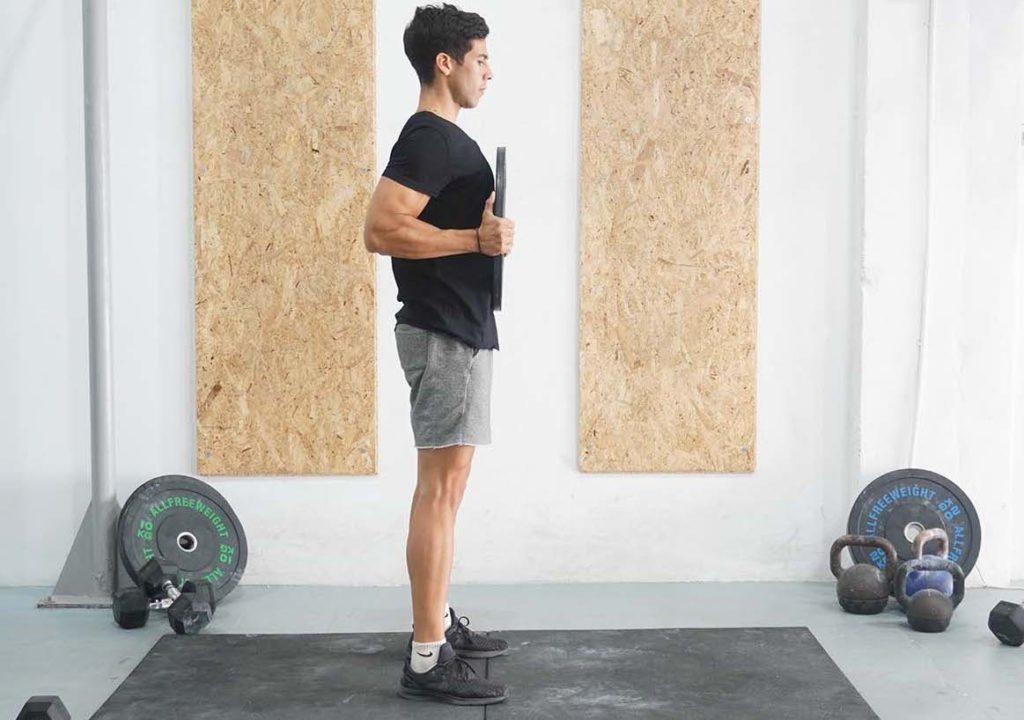
Our serratus anterior is the fourth muscle group that works during a plate press. Our serratus covers the upper lateral portion of the ribcage, connecting the scapula to the ribcage (5). The muscle group engages and produces shoulder protraction as we press the weight forward.
Aside from these muscles, our entire core works hard to keep us stable. The rectus and transverse abdominis, erector spinae, obliques, glutes, and other muscles flex isometrically, helping us remain rigid. Similarly, the upper back muscles engage and help us support the weight plate during each set.
Proper Form when Preforming the Plate Press
One of the essential tips to keep in mind for a safe and effective plate press is to warm-up well before doing the exercise. A combination of low-intensity cardio and dynamic stretching will raise your core body temperature, stabilize your joints, and prepare your muscles for the work you’re about to do.
Another important tip for avoiding injury with the plate press is to start with a light weight and get a good feel for the movement. You might possess good pressing strength, but the plate press is an exercise unlike any of the traditional activities you’ve done. We recommend starting with a 10 or 15-lb plate, performing 15 or more slow and controlled reps per set.
Our third tip for the plate press is to perform repetitions slowly, squeezing your chest as you press the plate in front of you. Doing so offers two benefits. First, you can maintain your balance more effectively because there aren’t any jerking motions that can cause you to lose your stability. Second, you can engage the correct muscles more effectively, feeling them work from start to finish on every repetition.
The fourth tip for effective plate pressing is to squeeze your inner chest muscles as hard as possible near the end of each repetition. Doing so might not seem all that important, but it makes a massive difference in how well you feel the exercise and its impact on hypertrophy. You can perform plate pinch presses if you struggle to feel your chest activating. We’ll discuss the variation in the following point.
Our next tip for solid plate pressing is to avoid protracting your shoulders too much. Your shoulders will roll forward as you press the plate, but you should resist the motion as much as you can and instead keep them retracted and depressed (back and down). Doing so is vital for maintaining your shoulder stability and squeezing your chest muscles more effectively.
The final tip relates to proper bracing. Pressing the weight in front of you will create instability and force your core to work hard in keeping you upright. We recommend engaging your abs before lifting the plate before you, even if that means not retracting your shoulder blades as much. Doing so is necessary for maintaining your balance and preventing the plate from pulling you forward.
Variations and Modifications of the Plate Press
1. Plate Pinch Press
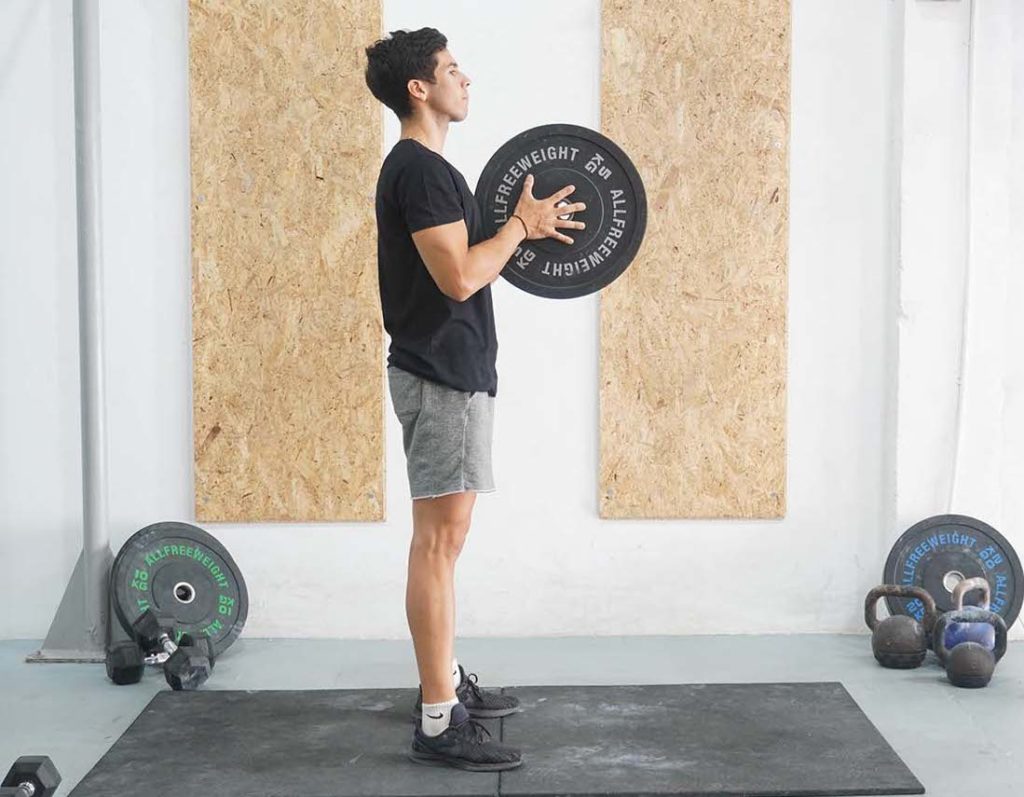
A plate pinch press is a variation we briefly mentioned in the previous point. The objective is to grab two or more smaller plates and squeeze them between your palms. From there, raise the plates in front of your chest and press them away from yourself. Squeezing the plates can be beneficial for chest activation because you must press in and forward. As such, your chest muscles work extra hard to keep the weights in position.
2. Lying Plate Press
The lying plate press is a simple variation if you lack the necessary core strength for the standard exercise. Instead of standing tall and pressing the weight forward, you have to lie on a bench or the floor and press vertically. Doing so doesn’t work your midsection and upper back as much, but the movement can be every bit as effective for your chest, shoulders, and triceps. The exercise is similar to the bench press, requires minimal equipment to perform, and can isolate your chest more effectively.
3. Standing Dumbbell Press
The standing dumbbell press is the same as a plate press, but you’re using a dumbbell for resistance. You have to position the dumbbell horizontally, grab both ends and press it away from yourself like you would during a plate press. Using a hexagonal dumbbell might be best.
4. Seated Plate Press
The seated plate press is another beneficial variation of the movement. Instead of standing, you have to sit on a chair or gym bench, raise the weight plate in front of yourself and press it away repeatedly. Performing the movement from a seated position can be beneficial for feeling more stable as you work your chest, shoulders, and triceps. Sitting is also helpful for those who struggle to perform reps slowly and without jerking the weight.
Mistakes to Avoid
Not Bracing Well
One of the most common mistakes with the plate press is not bracing your midsection effectively. Doing so makes it nearly impossible to maintain your balance because moving the weight away from your center of gravity creates significant instability. Avoid the error by engaging your abs before lifting the plate for each set and maintaining that rigid position until you finish the set.
Not Engaging Your Chest Muscles
The second common mistake with the plate press is moving the weight from start to finish without paying attention to muscle activation. Doing so makes each repetition less effective and prevents you from training your chest adequately. Avoid the error by performing each repetition mindfully, making sure to squeeze your chest muscles as you start pressing the plate away from yourself.
Shortening The Range of Motion
The third error to avoid with a plate press is shortening the range of motion. Trainees often pick more weight than they can handle and move it through a partial range of motion, stopping before extending their arms entirely. Doing so prevents you from training your muscles as effectively, making the movement less beneficial. Avoid the error by starting with the plate against your torso and extend your arms fully.
Lifting too Much Weight
The fourth common mistake with the plate press is using too much weight, especially as you first start learning the exercise. As discussed above, the plate press is unique because you have to press the weight away from your center of gravity. Lifting too much weight would make it near-impossible to maintain your balance, let alone train the correct muscles. Avoid the error by starting with 10 to 15 pounds, performing each repetition slowly, and with good body control.
Similar Exercises to the Plate Press
Bench Press (Barbell)
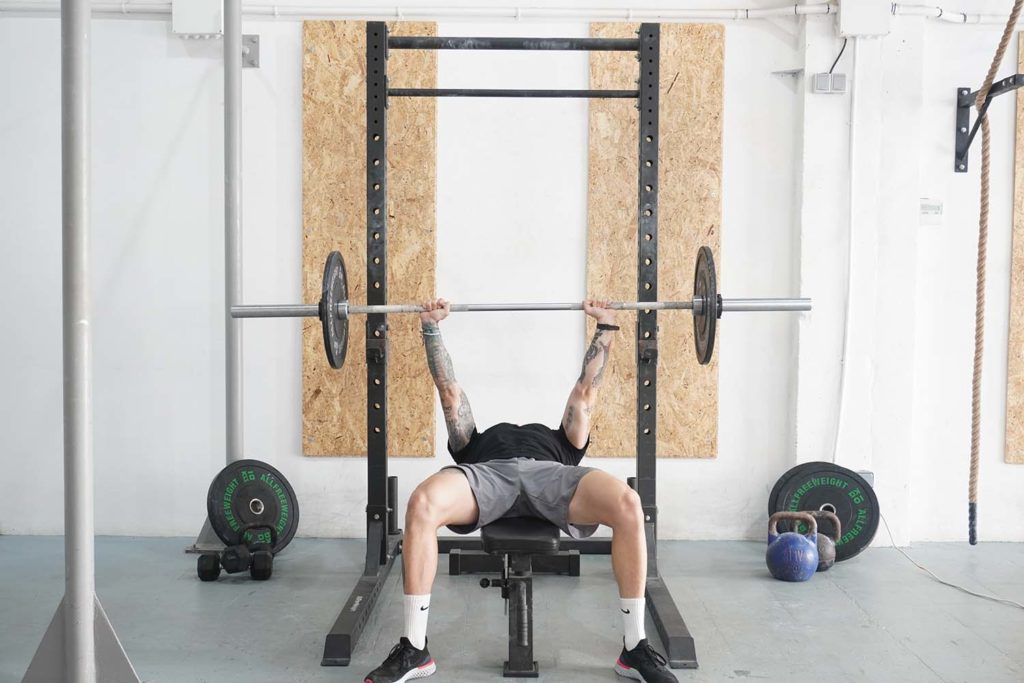
The barbell bench press is one of the most popular and practical gym exercises. Similar to a plate press, the objective is to press a weight away from yourself, strengthening your chest, shoulders, and triceps in the process (6). But, instead of standing vertical as you do, you lie on a flat gym bench and press a loaded barbell away from your upper body. A great benefit of the bench press is that you can adjust the resistance to fit your strength and increase the load as your capacity improves.
Push Up (Weighted)
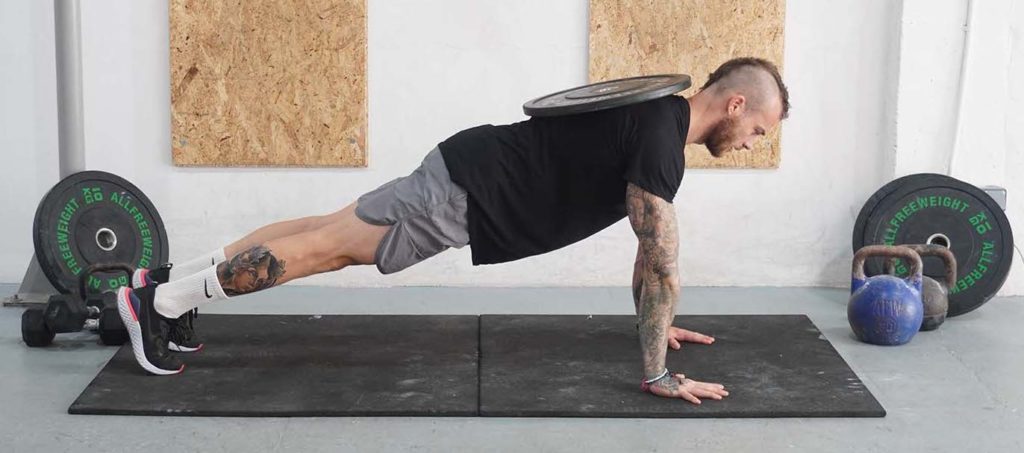
Similar to the plate press, weighted push ups are an effective exercise that only requires a plate or two to perform. The objective is to assume the push up position and have someone place a weight plate on your back. Doing so would provide extra resistance, making the exercise more challenging and beneficial for muscle and strength gain.
Pullover (Dumbbell)
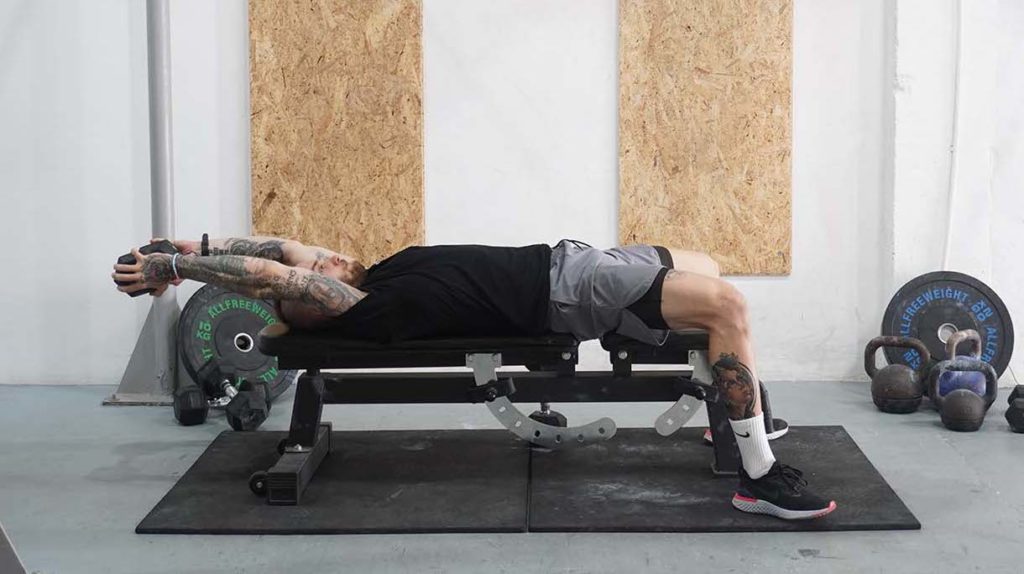
Dumbbell pullovers are a simple accessory exercise you can perform to strengthen your chest, triceps, shoulders, and lats (latissimus dorsi). The objective is to lie on a flat bench with a dumbbell in your hands. Position the weight vertically, placing your palms flat against the top weight plate. Once in position, bring the dumbbell back and behind your head, then pull it over until it hovers over your chest.
Chest Press (Machine)
Machine chest presses are another simple accessory exercise that works your pressing muscles – the chest, shoulders, and triceps. A huge benefit of performing presses on a machine is that you don’t have to worry about stability and can instead focus on contracting your pushing muscles on each repetition. Plus, the machine offers constant tension for your muscles, which can be beneficial for muscle gain. You can also adjust the resistance and increase the load as you get stronger.
Chest Dip
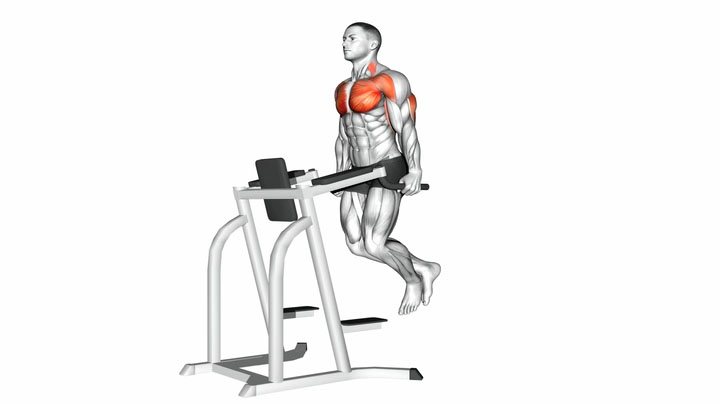
Similar to plate presses, chest dips are a movement that develops your chest, shoulders, and triceps while you’re vertical. Chest dips are also fantastic for your midsection and improve whole-body balance and stability. The objective is to support yourself on a pair of parallel bars, engage your upper body, take a breath, and dip by bending your arms. Go down until your elbows form a 90-degree angle and press yourself to the top, exhaling as you do.

